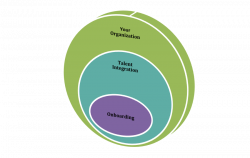 The integration of new talent, whether promoted from within or hired from outside the organization, represents a critical career inflection point for the new employee. Too often this process is overlooked in small businesses or simplified in larger organizations through a quick orientation or onboarding process.
The integration of new talent, whether promoted from within or hired from outside the organization, represents a critical career inflection point for the new employee. Too often this process is overlooked in small businesses or simplified in larger organizations through a quick orientation or onboarding process.
This leaves people to fend for themselves and attempt to adjust to their new organization and role essentially on their own. It will negatively influence their productivity and personal experience. It will lower your new employees’ perception about your company, and ultimately your top talent will leave. They will leave because they have options. Employees want to feel important, and they want to feel that they have been given a good opportunity to integrate into their new organization.
As the recruiter, your job is to find high-potential talent. You seek candidates who are well suited to your organization both in qualification and fit. People with a high potential for talent have a lot of opportunities, as clearly seen with technical and clinical people, making the race and “fight” for these employees especially challenging. What your company offers in terms of integration, both into the position and into the company, can be, if done correctly, a competitive advantage.
We define talent integration as the process and practice of blending (integrating) new hires into the organization. (It also includes the process and practice for integrating newly promoted managers and executives into their new role.)
What Distinguishes Onboarding from Talent Integration
Onboarding, by definition, is intended to help new employees acquire the necessary knowledge, skills, and behaviors to become effective members of your organization. Tactics commonly used include formal meetings, lectures, videos, print materials, or computer-based orientations to introduce newcomers to their new jobs in new organizations. Yet, what we see is that these processes often default to a more mechanical and routine approach (checklist style) than to a true process of personal and social integration with a developmental approach.
The key purpose of talent integration is to reduce the time for those new to their roles to become productive contributors (i.e., shorten the new job learning curve) and to swiftly anchor them into the organization through establishing strong relationships, support, and loyalty. Clearly, this practice helps retain employees, in addition to serving as a way to attract talent to your organization.
What’s Involved?
Talent integration involves a more formal, developmentally focused transition plan to help the new employee integrate into the organization — usually covering at least the first 90 to 180 days and in addition to standard onboarding tactics named above, it includes four core elements:
- A purposeful discussion between the new staff and their immediate supervisor within the first few days of hire to define clear expectations regarding job performance and key expected results, and to discuss how best to work with each other.
- Internal mentorship for the new employee to help them understand the organizational culture and “how work gets done around here.”
- Coaching for new managers, best done with an external/neutral executive/performance coach, to support the transition, especially if new skills are needed (i.e., technical/clinical person being promoted to a manager).
- Regular feedback meetings, monthly at a minimum, focusing on what is going well, where the person is challenged, what their ideas are, what they could use for help, etc. These discussions are dialogues and iterative in nature, verses a monologue from the boss.
6 Ways Recruiters Can Lead the Talent Integration Initiative
1. Before you start to search and screen candidates, make sure the hiring manager (or executive or HR manager) have accurately assessed and planned the following.
- What does the job require, and what really needs to be done (vs. what is stated on an outdated job description)?
- What skills, behaviors, and attitudes are required to achieve those requirements for success, now?
- What role adaptation is anticipated for the future?
2. Use behaviorally-based interview questions that probe the candidates’ experience history, decisions made, and accomplishments achieved.
3. Include culture-based questions to help determine their values and motivators, and compare them to your organizational values. A key question to use is: Tell me about your ideal company culture. Do this before you talk about your company’s culture.
4. Include a scenario-based problem for the candidate to resolve and report on.
5. Share with the candidates your organization’s talent integration process and comments and stories from staff who have experienced its value. Talk about success rates in hiring and keeping high potential talent, demonstrating a work place others will want to join.
6. Consider having top candidates complete a personality-based job performance indicator that measures their potential for success in different business environments and roles. (Though such an assessment should never be used as the sole criterion for selection, as part of a selection set, it can be a valuable tool to avoid hiring the wrong candidate for the job.) This can also be used as a tool to support and coach the new employee in areas that need to be addressed to promote a faster and more effective integration.
What if your organization does not yet have a talent integration process? Start by looking at what you do have in place. Make a recommendation to your boss or to management about what is missing, why it’s important to consider, and the value it can offer in attracting and retaining top talent.